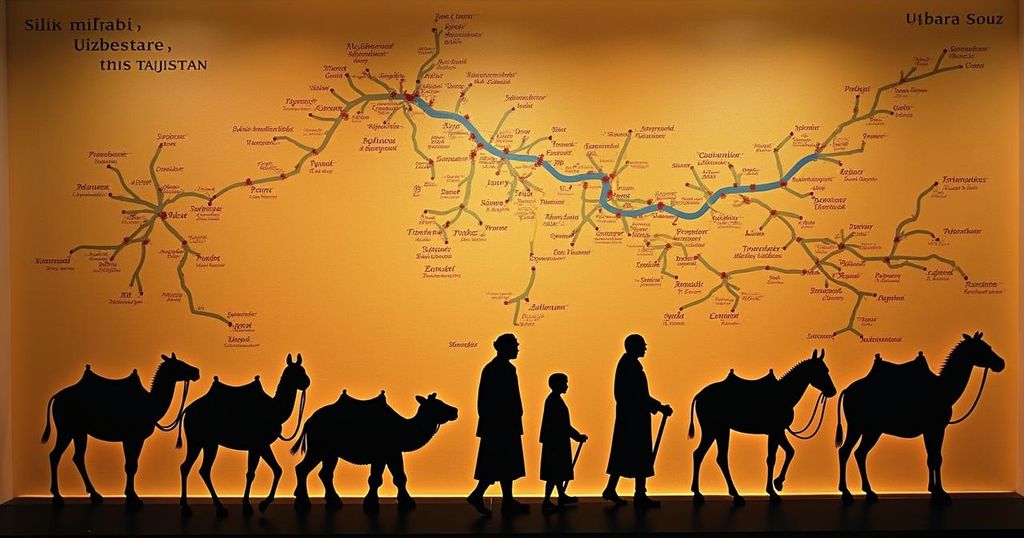The British Museum’s “Silk Roads” exhibition opened featuring artifacts from Uzbekistan and Tajikistan, challenging traditional views of a singular Silk Road. Running until February 23, 2025, it focuses on the period AD 500-1000 and illustrates the extensive cultural, technological, and religious exchanges facilitated by this network.
The prestigious British Museum has unveiled its highly anticipated exhibition titled “Silk Roads,” which commenced on Thursday. This exhibit provides an extensive exploration of the intricate networks that have interwoven cultures across Asia, Africa, and Europe for centuries. It features a remarkable collection of artifacts on loan from Uzbekistan and Tajikistan, including ancient chess pieces, emphasizing the pivotal role that Central Asia played in the historical narrative of the Silk Roads. Running until February 23, 2025, the exhibition seeks to challenge the conventional viewpoint that oversimplifies these ancient routes as merely pathways characterized by spices, camels, and sand dunes. It also dispels the myth of a singular Silk Road, illustrating instead a complex web of networks that fostered connections between diverse communities throughout Asia, Africa, and Europe. The British Museum particularly focuses on the period between AD 500 and 1000, a time marked by an acceleration in contacts, the flourishing of religions, and advancements in technology across a wide geographical expanse. According to the museum, “Rather than a single trade route from East to West, the Silk Roads were made up of overlapping networks linking communities across Asia, Africa and Europe, from East Asia to Britain, and from Scandinavia to Madagascar.” This collaborative exhibition is the result of partnerships with 29 national and international organizations, showcasing objects from Uzbekistan and Tajikistan that have not previously been displayed in the UK. Among the highlights from Uzbekistan, noteworthy artifacts include the oldest collection of chess pieces ever discovered, alongside a six-meter-long wall painting from the ‘Hall of the Ambassadors’ in Afrasiab, an ancient site in Samarkand. The Uzbekistan Art and Culture Development Foundation elaborates that, “The painting evokes the cosmopolitanism of the Sogdians from Central Asia who were great traders during this period.” Saida Mirziyoyeva, a daughter of Uzbek President Shavkat Mirziyoyev and a senior presidential aide, attended the exhibition launch, describing it as “A must-see for anyone passionate about Silk Road history!” The National Museum of Tajikistan has also contributed to the exhibition, lending items that pertain to the Buddhist culture from the 7th and 8th centuries, unearthed at monuments such as Ajinateppa, Kafarnihon, and Vakhsh. Notable objects on display encompass a Buddha figurine discovered in Sweden, an Islamic-style map created for the Christian king of Sicily, a Chinese ceramic dish salvaged from a shipwreck in Indonesia, a gilded silver cup indicating connections between Scotland and West Asia, a gold shoulder clasp adorned with Indian garnets from the Sutton Hoo burial in Suffolk, and a gold bowl found in Romania associated with the Avars, a nomadic group originating from the northeast Asian steppe. Beyond physical artifacts, the exhibition narrates the stories of influential figures encompassing an African king and a Chinese princess, illustrating the profound connections forged along the Silk Roads, as well as insights into religious exchanges and the dissemination of knowledge through the ages.
The Silk Roads represent a historic network of trade routes facilitating the exchange of goods, ideas, and cultures across vast distances. Contrary to popular belief, this network was not a singular path but rather a complex arrangement of overlapping connections amongst diverse communities. The British Museum’s exhibition aims to expand the understanding of these routes beyond common stereotypes, focusing on specific historical periods that witnessed significant cultural and technological exchanges. It also emphasizes the contributions of Central Asian nations such as Uzbekistan and Tajikistan, which played vital roles in this rich tapestry of history.
The British Museum’s “Silk Roads” exhibition is a monumental endeavor that not only showcases invaluable artifacts from Central Asia but also redefines the understanding of historical trade networks. By highlighting the interplay of cultures and the depth of interactions across these ancient routes, it invites visitors to appreciate the intricate connections that have shaped human history over centuries.
Original Source: timesca.com






